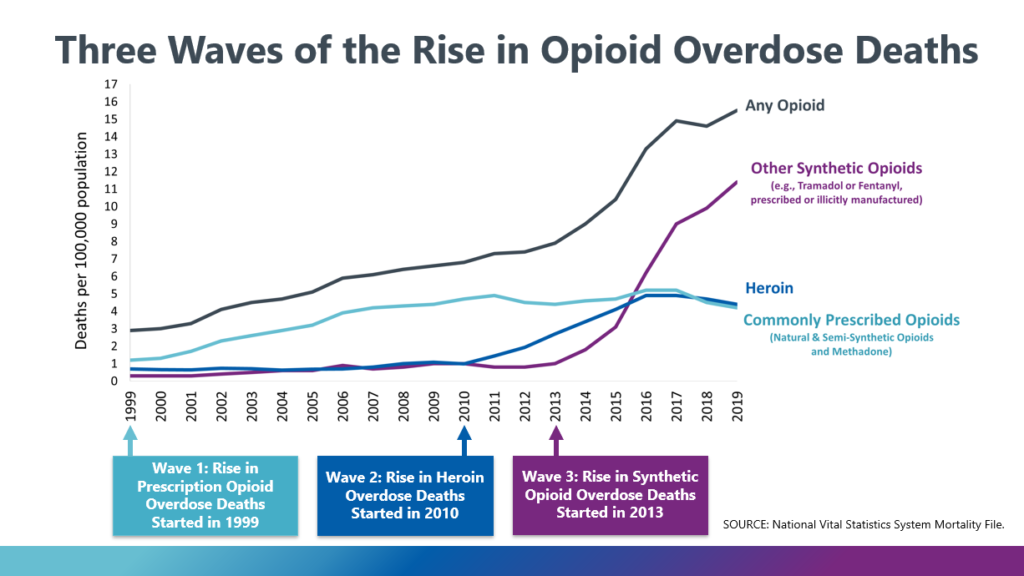How did Fentanyl Ushers in Third Wave of Opioid Epidemic? In the 1990s, the first wave of an opioid epidemic emerged with the over use of prescription of natural and semi-synthetic opioids and methadone. An increase in deaths related to the opioids would grow the following years. In 2010, the second wave arrived, this time driven by heroin, resulting in an alarmingly rapid increase in overdose deaths related to the drug.
“Over 28% of all opioid overdose deaths in 2019 involved heroin. Not only are people using heroin, they are also using multiple other substances, including cocaine and prescription opioids. Nearly all people who use heroin also use at least one other drug” ~ Centers for Disease Control and Prevention (CDC)
Fentanyl Ushers in Third Wave of Opioid Epidemic as overdose deaths involving illicit fentanyl have steadily increased.
Fentanyl marked the third opioid epidemic wave. Since 2013, overdose deaths involving synthetic opioids, particularly those involving illicitly manufactured fentanyl, fentanyl analogs, methamphetamine, and cocaine, have steadily increased. Data shows that the overdose involving synthetic opioids were twelve times higher than they were in 2013.

“The synthetic opioid fentanyl, a legal prescription pain medication, is now a black market commodity blasting through the street drug marketplace. Cheap and up to 100 times more powerful than naturally derived opioids, it is also lethal. Behind the trend is a growing body count: In the 12-month period that ended in April, more than 100,000 Americans, a record number, died from overdoses, according to preliminary data from the United States Centers for Disease Control and Prevention. The majority of the deaths were linked to synthetic opioids like fentanyl.” Sarah Maslin Nir/New York Times
Sarah Maslin Nir/New York Times
How is fentanyl taken?
Prescribed by a doctor, fentanyl can be given as a shot, a patch that is put on a person’s skin, or as lozenges (similar to how one uses cough drops) that are sucked in the mouth. The illegally used fentanyl (most often associated with recent overdoses) is manufactured in labs and sold in a variety of forms, including as a powder, made into pills that resemble other prescription opioids, dropped onto blotter paper, or put in eye droppers and nasal sprays.
What effects does fentanyl have on the brain?
Like heroin, morphine, and other opioid drugs, fentanyl works by binding to the body’s opioid receptors, which are found in areas of the brain that control pain and emotions. After taking opioids many times, the brain adapts to the drug, diminishing its sensitivity, making it hard to feel pleasure from anything apart from the drug. When people become addicted, drug-seeking and drug use over powers their lives.
After several times of using opioids many times, the brain adapts to the drug, diminishing its sensitivity, making it hard to feel pleasure from anything besides the drug. When people become addicted, drug seeking and drug use take over their lives.
Drugabuse.gov
Fentanyl Ushers in Third Wave of Opioid Epidemic: Fentanyl’s effects include:
- extreme happiness
- drowsiness
- nausea
- confusion
- constipation
- sedation
- problems breathing
- unconsciousness
People who are addicted to fentanyl have a hard time quitting the drug due to the uncomfortable withdrawals that occur when doing so. Such symptoms can include:
- muscle and bone pain
- sleep problems
- diarrhea and vomiting
- cold flashes with goose bumps
- uncontrollable leg movements
- severe cravings

The New York Times wrote an interesting article titled “Inside Fentanyl’s Mounting Death Toll: ‘This Is Poison.’” To read the article, Click Here.
If you’re struggling with fentanyl misuse, Connections in Recovery can help you by providing a Sober Companion, In-home Detox, Case Management, or put a medical and support team together for you.


